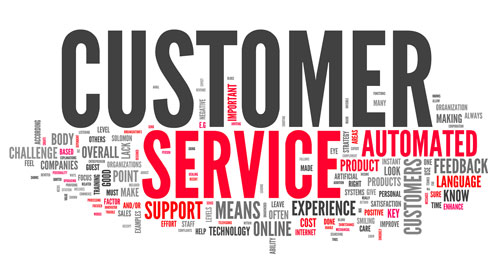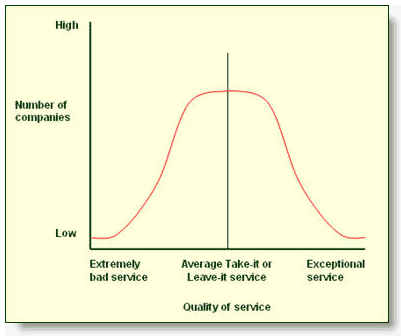The first rule of stellar service delivery is: Service is all about expectations.

You buy a product; you expect it to work the first time.
You go to a discount supplier, you expect the quality to be less than the high end dealer, but you still expect what you buy to work, first time every time.
When it comes to products, expectations are pretty clear. People expect a good quality product based on the price they are willing to pay for it.
When it comes to service, expectations can get a little fuzzy.
When a customer begins a relationship with you he or she already has a specific set of expectations. These expectations are based on their perceptions of you, your company and your industry. They are formed through personal past experience, and the experience of others with whom the customer interacts.
Consider the last time you went into a self-service gas station. What did you expect? Other than the pump to be working, not much else right? After all – you are doing all the work. You have the opportunity to satisfy, dissatisfy or impress–and two of these are bad.
Delivering below expectations is obviously bad, but in the context of creating loyalty, so is simply satisfying customers, because they are getting nothing more or less than they expect.
If it exceeds your expectations, you’re impressed, and if the service you receive meets your expectations you are satisfied.
If it is below your expectations – well, you know. Creating customer value and loyalty comes from consistently exceeding expectations.

Prof. Benjamin Schneider and Prof. David E. Bowen published an article called “Understanding Customer Delight and Outrage”. Delight and outrage?
That may sound a bit melodramatic but this concept is critically important to providing basic customer service. Consider this hypothetical bell curve measuring the quality of service delivery in general: Basically, most service falls into the median of the curve – the take it or leave it level of service. If you provide this level of service the customer will be satisfied.
You at least met their expectations. Schneider and Bowen actually break the bell curve distribution into four levels along a continuum:

Customer loyalty is the degree to which customers will patronize your business and your business alone because you’ve developed or created an emotional bond with them. You’ve gone beyond their expectations and addressed something more innate – their emotional needs as a consumer. Customers have come to expect fast, friendly service. They expect to get an answer to their questions. They expect you’ll answer their call promptly and return their messages. Do those things well and you’ll be in the game.
But will you win their loyalty? Not necessarily. If you fail, have you lost them forever? Again, not necessarily.
Research shows customers are willing to accept some failure in terms of these expectations. Fail continuously and that’s a different story. This is the “ambivalence” part of the model. Next time they need your product or service they may, if it’s convenient, patronize your business. But they won’t seek out your business purposefully. To do that, they must be delighted with your service. They must be so impressed with your service that they become a dedicated follower.
Schneider and Bowen refer to these customers as “apostles”. They will sing the praises of your business to friends, family and coworkers.
At the other end of the spectrum it’s possible to so utterly offend the basic needs of your customers that they’ll willfully take every opportunity to sabotage your business. They become a terrorist according to Benjamin and Bowen. They’ll tell every person who’ll listen about the time your business. Each time, they’re likely to embellish the story. So what creates such an extreme emotional reaction to service in some customers? According to Schneider and Bowen these reactions occur when you surpass the needs of a customer (delight) or you offend those needs. Not just fail to meet them – you (in the mind of the customer) intentionally deprived them of those needs.
What are these powerful dynamics?
1. Deprived of Equity / Justice
Customers want to be treated fairly. They want to know that the service and product they receive is as good as that received by any other customer. Consider a study done by a consumer advocate group. They asked samples of airline passengers from numerous airports what they’d paid for their ticket. They found less than 10% of passengers paid the same price for their ticket even though they flew from the same city. The results incited outrage among travelers who saw no justification for paying more, when they had received the same seating and service.
Equity and justice is even more at issue when companies resolve customer problems. At times service or product experience is so bad customers will seek compensation for their time, effort and inconvenience. A participant in one of our customer service workshops shared the following:
“I purchased a large screen TV from one of those audio-video-electronics mega stores. The first one just did not work so we had to bring it back. The second one, which we had to wait two weeks for, had a large crack along the bottom of the screen. Again, we didn’t know until we unpacked it. I’d already lost a day of work going to pick it up and unpacking it. When I brought it back they tried to charge me $37.00 because I returned it without the box. It was destroyed unpacking it. I was stunned. Even after explaining the circumstances to the retail associate he made me talk to the store manager who acted like he was doing me a favor waiving the charge.”
Equity and justice means making customers feel they’re getting a comparable service and product at a fair price. It also means problems are resolved to their satisfaction and that companies consider the cost of the customer’s time and inconvenience when making amends.
2. Lack of Respect
Nothing is more basic and elementary to effective service than the need for customers to feel respected. In fact, studies show merely respecting customers does not distinguish your business or service. That’s because customers expect it. It’s when they perceive a lack of respect that things get volatile. For example:
Rachael brought her car into a repair shop to get new tires put on. After looking the vehicle over the mechanic recommended new brakes. Rachael was puzzled since she hadn’t noticed any problem with the brakes. In fact, she had gotten it inspected just two months earlier. “Well they don’t look them over the way we do.” He rattled off some automotive terms to convince her. Rachael was still hesitant. “Why don’t we call your husband,” he said. With that Rachael told him to put the tires back on her vehicle – she’d be taking her business elsewhere.
Respect means treating customers the same – regardless of gender, race or age. It means listening to the customer’s problem and responding in an empathic tone. It means your non-verbal behavior demonstrates concern and attentiveness.
When it comes to service, clearly understand what it is your customers want, expect and need, then shape your people and processes to deliver a level of service which reflects these.
About the Author
Ray Miller is Managing Partner of The Training Bank, a Training and Consulting firm specializing in Customer Focus, Service Improvement, Leadership and fully customized training solutions. He is also co-author of the book That’s Customer Focus.




